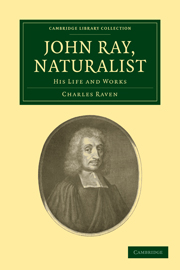Book contents
- Frontmatter
- Contents
- Preface
- Introduction
- ABBREVIATIONS
- Chapter I Boyhood and Youth
- Chapter II At Cambridge University
- Chapter III First Studies in Science
- Chapter IV The Cambridge Catalogue
- Chapter V The Years of Travel
- Chapter VI The English Catalogue
- Chapter VII The Years of Varied Output
- Chapter VIII The Structure and Classification of Plants
- Chapter IX The History of Plants
- Chapter X The Flora of Britain
- Chapter XI Last Work in Botany
- Chapter XII The Ornithology
- Chapter XIII The History of Fishes
- Chapter XIV Of Mammals and Reptiles
- Chapter XV The History of Insects
- Chapter XVI Of Fossils and Geology
- Chapter XVII The Wisdom of God
- Conclusion
- Index
Chapter XIV - Of Mammals and Reptiles
Published online by Cambridge University Press: 07 September 2010
- Frontmatter
- Contents
- Preface
- Introduction
- ABBREVIATIONS
- Chapter I Boyhood and Youth
- Chapter II At Cambridge University
- Chapter III First Studies in Science
- Chapter IV The Cambridge Catalogue
- Chapter V The Years of Travel
- Chapter VI The English Catalogue
- Chapter VII The Years of Varied Output
- Chapter VIII The Structure and Classification of Plants
- Chapter IX The History of Plants
- Chapter X The Flora of Britain
- Chapter XI Last Work in Botany
- Chapter XII The Ornithology
- Chapter XIII The History of Fishes
- Chapter XIV Of Mammals and Reptiles
- Chapter XV The History of Insects
- Chapter XVI Of Fossils and Geology
- Chapter XVII The Wisdom of God
- Conclusion
- Index
Summary
So correct was his genius that we view a systematic arrangement arise even from the chaos of Aldrovandus and Gesner. Under his hand the undigested matter of these able and copious writers assumes a new form, and the whole is made clear and perspicuous.
Thomas Pennant of Ray, Synopsis of Quadrupeds (1771), Preface, p. iii.It was, as we have seen, on 18 April 1684 and after the completion of the Historia Piscium that Tancred Robinson, writing from Geneva, revived Willughby's project for a General History of Nature. The proposal in its main outline was clear—that he should produce a series of hand-books or Synopses surveying the whole order of Nature, and anticipating the work carried out in the next century by Linnaeus. According to the classification then in vogue this would have meant surveys of Animals, Reptiles, Birds, and Fishes; Exanguia, that is Cephalopods, Crustaceans, Shell-fish, and Insects; Plants; and Fossils—these including Minerals as well as ‘formed stones’. Ray had got the material for some of these: to condense the Ornithology and the Ichthyology and even the Plants would not be a very serious business. But to deal with Animals and Reptiles was to break new ground; and the rest, except for some small notes of Insects, were wholly untouched. We have seen that he very rapidly put together the Synopsis Stirpium Britannicarum and followed it up with the Sylloge Europeanarum.
- Type
- Chapter
- Information
- John Ray, NaturalistHis Life and Works, pp. 371 - 387Publisher: Cambridge University PressPrint publication year: 2009First published in: 1942



